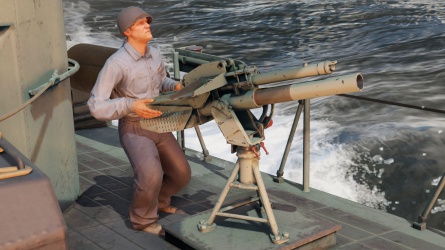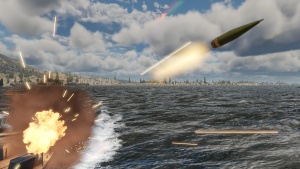Mk 2 mortar

Contents
Description
The Mk 2 mortar is a 81 mm mortar seen on American naval craft. As a mortar, the projectiles are fired at a high parabolic trajectory and at a slow speed. While making it a difficult weapon to use against fast-moving boats, a direct hit will cause devastating damage to them.
Vehicles equipped with this weapon
- PTF-7 (Modification)
- USS Flagstaff
- USS Tucumcari
- PT-810
- PT-811
- PT-812
General info
The Mk 2 mortar is a supporting weapon on the naval craft it is mounted on, never to be considered a naval craft's main armament. Though small in size, the projectiles it fires are of high-explosive nature and so the appropriate targets should be selected when engaging with the weapon.
Available ammunition
The Mk 2 mortar does not give any ammunition options that users can choose to fire. However, the Mk 2 mortar fires a high-explosive projectile that can cause good damage should it hit its desired target.
Comparison with analogues
Give a comparative description of weapons that have firepower equal to this weapon.
Usage in battles
Describe the weapon in the game - its distinctive features, tactics of usage against notable opponents. Please don't write a "guide" - do not impose a single point of view, but give the reader food for thought.
Pros and cons
Pros:
- High-explosive payload can cause large amounts of damage to lightly-armoured craft, and can still cause damages in a near-miss
- High parabolic firing angle can allow the naval craft mounts to fire at targets across island land masses without direct line-of-sights
- Unlike other mortars, such as Ordnance ML 4.2-inch, AI will automatically choose targets and engage them without any player action needed (as long as the gunner targets (default hotkey: E) are toggled to engage targets)
Cons:
- Projectiles fired are very slow, and so leading shots can be difficult
- Due to slow projectile speed and low accuracy, AI gunners are unlikely to hit coastal vessel, and might struggle even with large, bluewater targets.
History
After World War II, The United States Navy began looking to improve the surface and shore attack capabilities of offshore patrol craft. The requirement came from experience with patrol boats during World War II. The result came with experiments on PT-810 and its family of patrol boats to improve armament including mounting 40 mm Bofors L/60 Mark 3 cannons, 20 mm Oerlikon cannons, torpedoes, and the Mk.2 81mm mortar. The 81mm calibre was the standard ammunition for the United States heavy mortars during the 20th century, beginning with the Stokes Mortar design from World War I. The Mark 2 was a different weapon from US Army mortars. Developed by Naval Weapons Station Crane in Indiana, the first users of the Mark 2 were the United States Coast Guard. As their duties included search and rescue of aircraft that are forced to ditch at sea, the Mark 2 mortar was used to fire illumination rounds to aid the pilots of these crafts. It was found to be an effective replacement to the starburst rounds of the 3-inch guns used on their cutters before the adoption of the Mark 2 in 1962. It was brighter, had a higher rate of fire, and created less fouling than the 3-inch guns.
Capable of either direct or indirect fire depending on the situation, two mounts exist for the Mark 2 Mortar. The Mark 2 Mod 0 is a standalone weapon on a tripod, while the Mark 2 Mod 1 mounts an additional AN-M2 machine gun. The concept for this mount came from the suggestion of the Coast Guard. Testing started at Curtis Bay, Maryland before the Navy began testing at Dalgreen, Virginia in late 1964. The Navy and Coast Guard used the Mark 2 in both mounts in a variety of roles during the Vietnam War from barrack barges to PBRs and similar riverine patrol craft to Coast Guard cutters to navy fast patrol craft such as PTF-7 of the Nasty-class and naval bases at Nam Cam and Song Bong Doc codenamed Sea Float/Solid Anchor and Breezy Cove respectively.
Major differences between the Army mortars and the Mark 2 include a recoil-counterrecoil system for reducing the brake load, free-swinging capability for training and elevation, and a trigger for alternative means of firing the weapon in a direct fire mode. Ammunition types along with the high-explosive featured in the game included illumination rounds used by the coast guard and the Mark 120 Mod 0 anti-personnel fléchette round.
Media
Excellent additions to the article would be video guides, screenshots from the game, and photos.
See also
External links
| Naval special armaments | |
|---|---|
| USA | |
| Mortars | 7.2-inch T37 · Mk 2 |
| Rockets | 5-inch GPSR Mk.7 · Mark 108 Weapon alfa |
| Missiles | RIM-24A |
| Germany | |
| Rockets | M/50 Bofors |
| Missiles | Strela-2M |
| USSR | |
| Mortars | BM-37 · RBM · RBU-1200 · RBU-2500 · RBU-6000 · RKU-36U |
| Rockets | BM-14-17 · BM-21 · M13 · M-8 |
| Missiles | Volna-M |
| Britain | |
| Mortars | Ordnance ML 4.2-inch mortar |
| Japan | |
| Rockets | 4.5-inch BBR Mk.7 (USA) · Mark 108 Weapon alfa (USA) |
| Italy | |
| Missiles | Nettuno |




